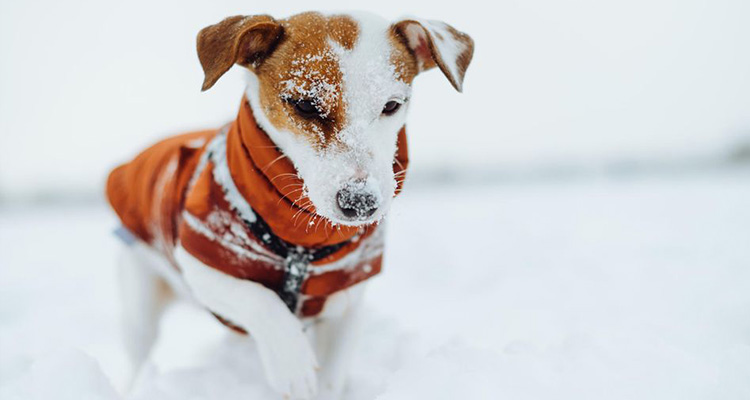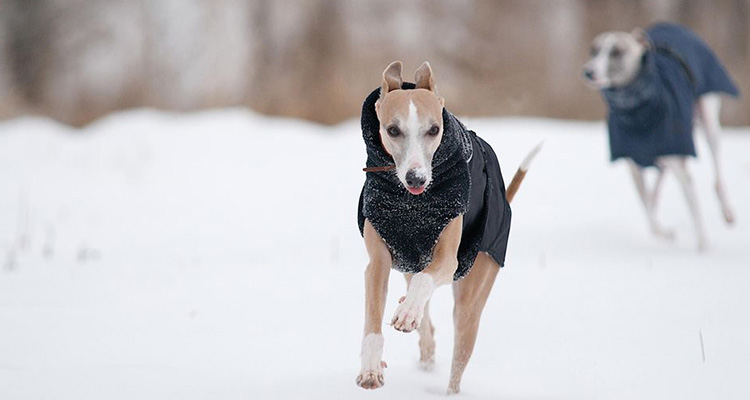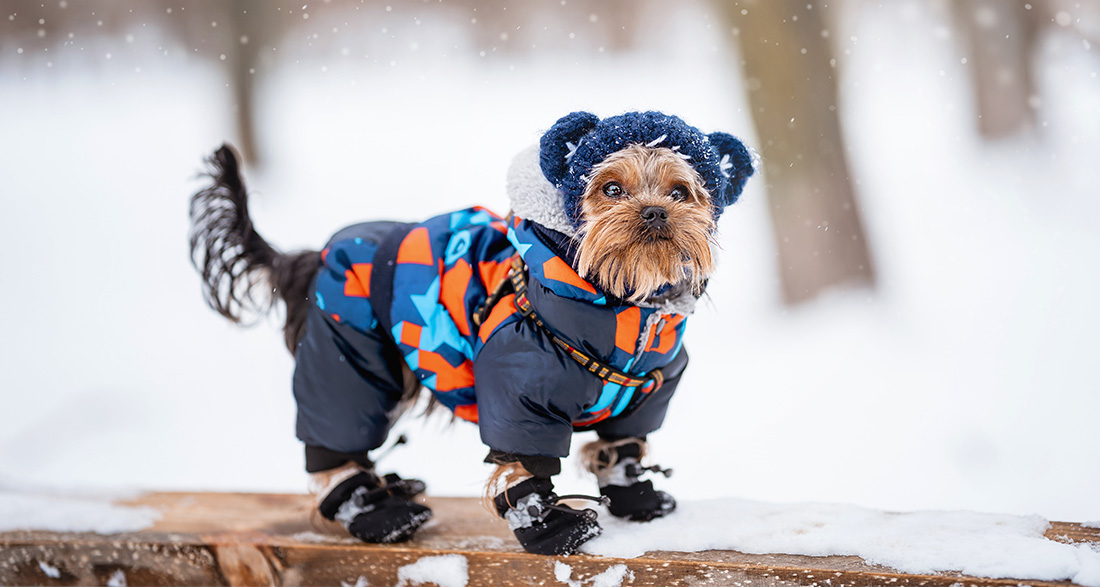Dogs wearing winter coats are often ridiculed by many people. “An animal doesn’t need a coat; it has fur, after all,” is a common belief. Wrong! We’ll reveal when dog coats can be useful in winter and what you should consider when buying.
As it gets colder and wetter outside, you increasingly see dogs in winter or raincoats on the streets. Those who delve into the topic will quickly realize that the visual aspect plays a much smaller role than expected. After all, winter coats for dogs serve a similar purpose as their human counterparts: they keep warm and protect against wind. And despite fur, this can be beneficial for dogs.
Which dogs need winter coats?
Breeds with a lot of fur, such as Huskies, Australian Shepherds, or Samoyeds, have significant advantages in winter as they are naturally well-protected against the cold. Breeds with short fur and lacking undercoat, such as Dobermans, Greyhounds, Dachshunds, French Bulldogs, or Jack Russell Terriers, may find the use of a winter coat sensible to prevent chilling and freezing.
Not only the breed matters when it comes to dog winter coats. Depending on the age of the animal, such attire may be useful – especially for puppies and elderly dogs. Young dogs often lack a well-developed immune system, making them more susceptible to cold, so avoiding drastic temperature changes is advisable.
For senior dogs, this issue may resurface in old age as the immune system weakens, and muscle atrophy sets in. A winter coat provides a solution, ensuring that the dog can still enjoy longer walks and snowy outings in winter.

Improving the well-being of sick dogs is another benefit of a warming winter coat. It not only protects already sick dogs from worsening conditions but also makes daily life easier for animals with joint problems and organ weaknesses.
The use of a coat can also be sensible for dogs actively involved in canine sports. The coat is not meant for training but for the breaks in between. It helps keep the warmed-up muscles from cooling down immediately, minimizing the risk of injuries.
Finally, a winter coat for dogs can be used to acclimate animals from abroad to local temperatures. For example, if a dog from a shelter spent the last few years in sunny Greece, the cold winter can be a significant adjustment. Thanks to a coat, the animal is well-prepared for the temperature difference. After a period of acclimation, the coat may eventually be omitted if necessary.
Types of dog coats for winter
As diverse as dogs are, so are the types of winter coats available on the market. Here’s a brief overview:
Dog coats with warming lining: all-rounders among winter dog coats
Coats with a warming lining, such as fleece, provide ample freedom of movement for the dog. They snugly fit the dog’s body and are also low-noise. While the upper side is made of water-resistant material, the interior is well-insulated. Fleece, unlike cotton, dries quickly.
Dog coats with belly protection: for breeds with thin belly fur
Breeds with little belly fur in winter require additional protection. Coats with belly protection warm from all sides, preventing bladder infections or colds. The belly protection is either threaded through the chest area between the front legs or fastened with a wider (Velcro) strap going from one side to the other. Especially for males, it should be ensured that the coat provides enough room for them to continue their business.
Dog snowsuits: for extensive snowy walks
Dog snowsuits are usually quilted dog clothing that may also cover the legs. Their primary purpose is to keep the dog warm. Some models even come with a hood and reflectors for increased visibility.
Such a product is worthwhile for those who don’t want to give up extensive walks in the snow during winter. These snowsuits are well-insulated everywhere and ensure that the dog doesn’t get too cold even after several hours in the cold.
What to consider when buying a winter coat for dogs
As dogs are generally very active, it’s crucial that the winter coat fits the individual size and shape perfectly. Additionally, attention should be paid to the presence of reflective strips for visibility in the dark. Reflective attachments on dog coats are a good complement to dog light-up collars.
Now, here are the key criteria that dog owners should consider when buying a winter coat for their dog, summarized:
Fit: to prevent slipping or pinching
Just like with our own clothing – if it’s too loose, we feel cold, and if it’s too tight and pinches, we’re also uncomfortable. Similarly, our four-legged friends likely feel the same way; a good fit when buying winter coats for dogs is crucial. Only when the coat fits properly can it provide adequate warmth.
Therefore, be sure to try on a few models with your dog and compare them. Some dog coat manufacturers offer perfectly tailored, breed-specific models for certain breeds with specific body characteristics – for example, Dachshunds with very long backs and very short legs.
When trying on, ensure that the dog can move unrestrictedly, and its legs and tail are free. A coat collar protects the neck area from cooling. Dogs with little belly fur also need a model that covers and warms this area.
Also, consider that the winter coat for dogs should match the dog’s collar or harness and leash. If you usually use a harness, the dog coat on the back should have an opening for the leash. If you secure your dog with a collar, a too-large collar on the dog coat may not make much sense.
Size: measure beforehand
To ensure the winter coat fits correctly, take a few measurements of your furry friend beforehand. Remove the collar and measure the circumference of the neck. Add 5 cm to calculate the opening of the winter coat.
Then measure the circumference of the widest part of the chest and add 5 cm to that as well. Lastly, measure from the base of the neck to the base of the tail, determining the length of the back. Compare these measurements with those provided by dog coat manufacturers to find the optimal size for your pet.
Material: preferably water-resistant and warm
For the winter coat to withstand all walks, it should be made of robust materials that are washable. Most such coats consist of a warming lower layer and a water-resistant upper layer.
Ensure that the coat also has a water-resistant material at the belly area, not just on the back. In bad weather, not only does rain come from above, but splashing water and wet grass can also quickly make the dog’s belly area wet.
WARNING
Certain fabrics may cause allergic reactions in some dogs. Keep an eye out for repeated itching, sneezing, hives, swelling of the face, ears, lips, eyelids or earflaps, red and inflamed skin, diarrhea, and/or vomiting.

Dog’s activity level: not everyone moves enough
Depending on the dog’s activity level, there are different requirements for a winter coat. Thinner models may be suitable for dogs that run a lot. Less mobile dogs and seniors should preferably be equipped with well-insulated coats as they have fewer muscles and move more slowly. Those involved in canine sports can use the coat only during breaks to prevent the dog from cooling down too much.
How do I get my dog used to the coat?
Many dogs are initially not big fans of winter coats; after all, putting on such a piece of clothing is usually unfamiliar and can cause stress. To acclimate your pet to the new winter gear, you should proceed slowly and with patience:
- Present the coat to your dog, allowing them to look at it and sniff it. Reward their approach with a treat to create a positive association.
- If your dog shows no more fear when you hold the coat at head level, you can take the next step. Let the dog stick their head through the opening, and reward them for each piece they bravely pass through.
- Once the head is through the opening, you can then hold the dog coat over the body of the animal so that the four-legged friend doesn’t feel it on their back yet. If they remain relaxed, you can slowly unroll the winter coat – always accompanied by rewards.
- In the final step, close the dog coat and praise your pet extensively. Now, you’re ready for a walk!


